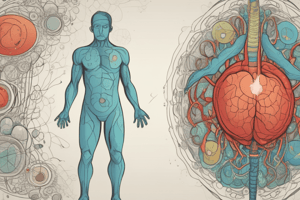Podcast
Questions and Answers
Which hepatitis virus requires another hepatitis virus for infection?
Which hepatitis virus requires another hepatitis virus for infection?
- Hepatitis A virus
- Hepatitis E virus
- Hepatitis C virus
- Hepatitis B virus (correct)
What is a characteristic feature of the Hepatitis B virus structure?
What is a characteristic feature of the Hepatitis B virus structure?
- Single-stranded RNA
- Lacks an envelope
- Envelope with double-stranded DNA (correct)
- Circular single-stranded RNA
How is Hepatitis C virus primarily transmitted?
How is Hepatitis C virus primarily transmitted?
- Fecal-oral route
- Sexual intercourse
- Blood transfusion (correct)
- Perinatal transmission
Which hepatitis virus is known to mainly cause acute infections?
Which hepatitis virus is known to mainly cause acute infections?
What is the role of reverse transcriptase in HBV infection?
What is the role of reverse transcriptase in HBV infection?
How does the immune response contribute to cell death in infected hepatocytes?
How does the immune response contribute to cell death in infected hepatocytes?
Which cytokines are primarily responsible for triggering inflammation and destruction of liver cells in viral hepatitis?
Which cytokines are primarily responsible for triggering inflammation and destruction of liver cells in viral hepatitis?
Which process is responsible for the fever, malaise, and discomfort experienced in viral hepatitis?
Which process is responsible for the fever, malaise, and discomfort experienced in viral hepatitis?
What is the cause of nausea and vomiting in viral hepatitis?
What is the cause of nausea and vomiting in viral hepatitis?
Which symptom is indicative of decreased bile production by the liver in viral hepatitis?
Which symptom is indicative of decreased bile production by the liver in viral hepatitis?
Which liver enzymes are commonly elevated in the blood as an indicator of liver damage in viral hepatitis?
Which liver enzymes are commonly elevated in the blood as an indicator of liver damage in viral hepatitis?
Which extrahepatic manifestations can occur in chronic hepatitis B and C infections?
Which extrahepatic manifestations can occur in chronic hepatitis B and C infections?
Flashcards are hidden until you start studying
Study Notes
- Hepatitis A virus causes acute infection, transmitted through fecal-oral route, and lacks an envelope in its structure.
- Hepatitis B virus can cause both acute and chronic infections, transmitted through sexual intercourse, blood, and perinatal transmission, and has an envelope in its structure with double-stranded DNA.
- Hepatitis C virus can also cause both acute and chronic infections, transmitted through similar routes as HBV, and has an envelope in its structure with single-stranded RNA.
- Hepatitis D virus mainly causes chronic infection, requires HBV for infection through co-infection or superinfection, and has an envelope in its structure with circular single-stranded RNA.
- Hepatitis E virus mainly causes acute infections, transmitted fecal-orally, and lacks an envelope in its structure with single-stranded RNA.
- The process of how these viruses infect hepatocytes involves shedding off outer coatings, releasing RNA, synthesizing proteins, using host cell machinery to replicate, and causing cell damage through lysis.
- HBV utilizes reverse transcriptase to convert RNA to DNA within the host cell, leading to continuous replication and potential incorporation into the host genome.
- The immune response to infected hepatocytes involves cytotoxic T cells recognizing viral proteins presented on MHC-1 complexes, leading to cell death through apoptosis.
- Liver damage from viral infection triggers the production of cytokines like interleukin-1 and interferon gamma, leading to inflammation and destruction of liver cells.- Interleukin-6 and tumor necrotic factor alpha trigger a prostaglandin process in the brain, causing fever, malaise, and discomfort.
- Liver damage leads to accumulation of hepatotoxins in the blood, causing nausea, vomiting, and potential dehydration.
- Hepatotoxins can stimulate the chemo trigger zone in the brainstem, leading to vomiting and electrolyte imbalances.
- Liver damage can result in jaundice, with bilirubin accumulating in the sclera and skin, causing a yellowish discoloration.
- Conjugated and unconjugated bilirubin levels increase in the blood due to liver cell damage.
- Decreased bile production by the liver leads to clay-colored stools due to decreased stercobilin.
- Inflammation of the liver can cause hepatomegaly and right upper quadrant abdominal pain.
- Liver enzymes AST and ALT increase in the blood as an indicator of liver damage.
- Decreased clotting proteins production by the liver can result in prolonged PT and PTT.
- Chronic infections with hepatitis B and C viruses can lead to extrahepatic manifestations like arthritis, vasculitis, myocarditis, and glomerulonephritis.
- Chronic hepatitis B and C infections can increase the risk of fibrosis, cirrhosis, cellular dysplasia, and hepatocellular carcinoma.- SLE can present with various clinical manifestations and detectable abnormalities in lab tests.
- Encourages viewers to like, comment, and subscribe to the channel.
- Provides links to Facebook and Instagram accounts for communication.
- Mentions a Patreon account for donations to support video production.
- Expresses gratitude towards viewers and signs off with a positive message.
Studying That Suits You
Use AI to generate personalized quizzes and flashcards to suit your learning preferences.





